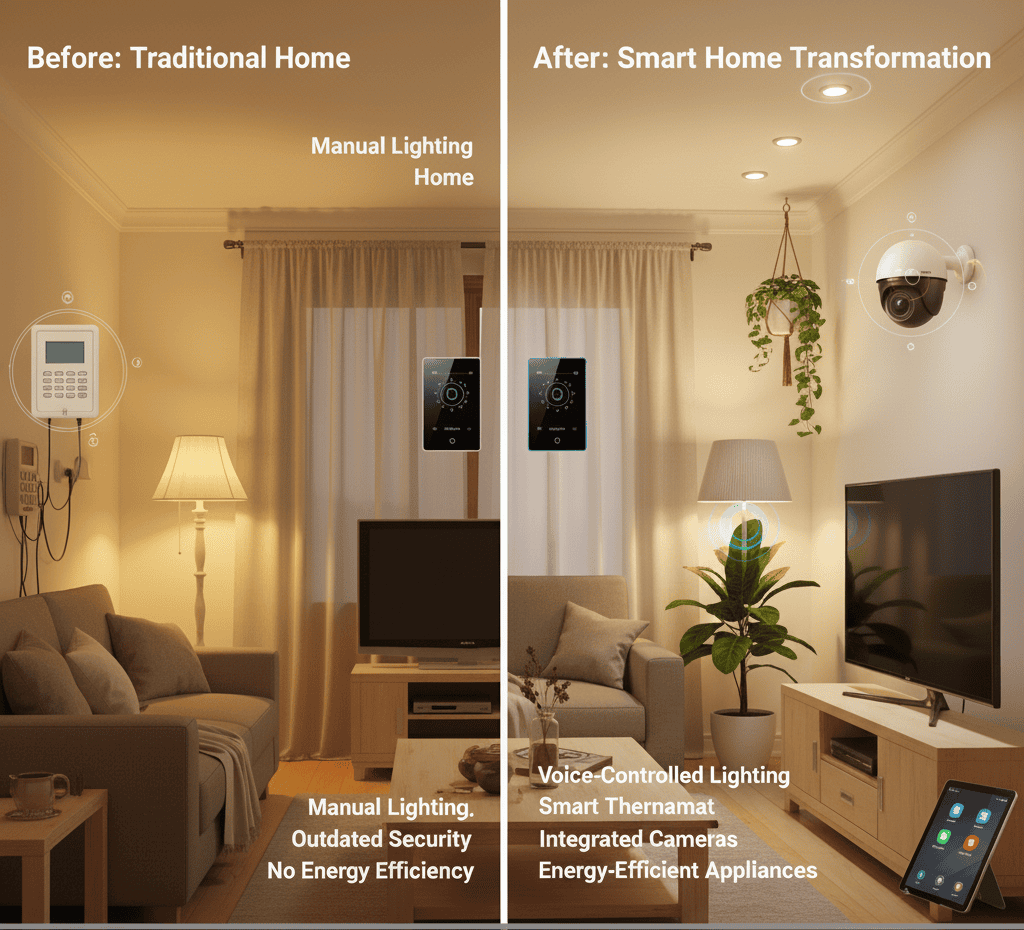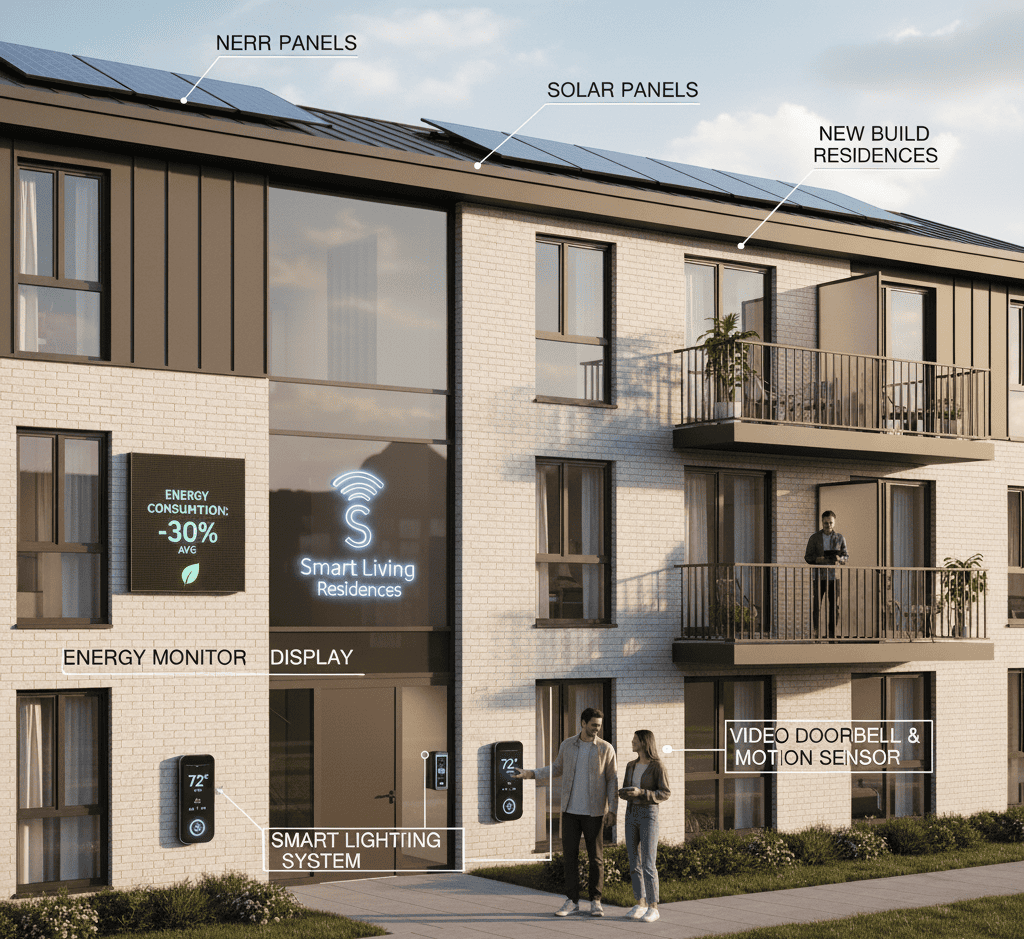Smart Home Integration In Interior Design
Smart home integration adds technology to make your home smarter, more comfortable, and easier to manage. It brings features like automated lighting, climate control, voice assistants, and energy-saving appliances directly into your interiors. Instead of being extra gadgets, these elements become part of your home’s design, so you enjoy both style and function in one space.
This trend matters now more than ever. As technology advances and lifestyles get busier, you expect your home to save time, improve safety, and lower energy use while still looking modern. With smart devices, AI-driven tools, and connected systems becoming more affordable, you can create a home that feels personalised, efficient, and ready for the future.
Evolution Of Smart Homes
Smart homes have come a long way from simple automation, like remote-controlled lights or security alarms, to advanced IoT devices that connect appliances, lighting, and entertainment systems. Today, full-home smart systems let you control almost every function with a phone or voice command. As this technology has evolved, interior design has also had to adapt. Moving from just arranging furniture and décor to planning spaces that hide devices neatly, allow smooth connectivity, and balance aesthetics with high-tech functionality.
Key Components of Smart Home Integration
Benefits of Smart Home Integration
- Comfort & Convenience: Smart homes make daily life easier. For example, you can schedule your lights and thermostat so your living room feels cosy the moment you walk in.
- Energy Savings & Sustainability: Automated lighting and climate systems switch off when not needed; for instance, smart thermostats lower energy use by adjusting the temperature while you’re away.
- Increased Property Value: Homes with built-in smart systems attract buyers. A house that already has smart lighting, security, and appliances often sells faster and at a better price.
- Safety & Security: Smart locks, doorbell cameras, and sensors protect your family. Imagine checking who’s at your door or locking it from your phone, even when you’re at work.
- Well-being: Smart systems improve comfort and health. For example, lighting that mimics natural daylight or air-quality monitors that adjust ventilation can boost mood and productivity.
Practical Tips for Homeowners
- Plan from the Design Stage: Think about smart features while designing or renovating, not after. This helps hide wires, place outlets correctly, and blend devices into your interiors.
- Prioritise Key Features: Start with systems that make the biggest difference, like smart lighting, thermostats, or security. These give high value for relatively low investment
- Choose the Right Ecosystem: Pick devices that work well together, such as Google Home, Alexa, or Apple HomeKit, so everything connects smoothly.
- Match Your Style: Select devices that fit your home’s look. Sleek switches, hidden speakers, or stylish smart appliances, so technology doesn’t feel out of place.
- Plan for Future Upgrades: Choose flexible systems that can expand later. For example, start with lighting and add smart blinds or energy management when your budget allows.
Interesting Facts, Data & Statistics
Global Growth & Market Trends
- Global Market Value: The global smart home market was valued at $127.67 billion in 2024 and is projected to reach approximately $1.4 trillion by 2034, growing at a CAGR of 16.8%.
- Regional Growth: North America led the market in 2024, holding a 37% share, while Asia Pacific is expected to grow at a double-digit CAGR of 32.24% through the forecast period.
Popular Smart Home Devices
- Top Devices: Smart speakers (e.g., Amazon Echo, Google Nest) and smart TVs are among the most commonly found smart home devices in U.S. households.
- Security Devices: Smart security cameras, locks, and sensors are increasingly popular, with the smart home security industry projected to generate $61.97 billion by 2029, growing at a rate of 13.81% from 2024.
User Attitudes & Preferences
- Value Perception: 88% of smart home device owners believe their devices are worth the money, and 60% report saving money through energy efficiency and other benefits.
- Convenience Factor: Convenience is the most significant factor in smart home device usage across all demographics, with 46% of users citing it as their primary motivation.
Financial Incentives
- Property Value Increase: Installing smart devices can increase a home's resale value by up to 5%, with smart security systems contributing to a 5% increase and smart thermostats adding a 3% increase.
- Energy-Efficient Upgrades: Investing in energy-efficient technologies like solar panels, smart meters, EV chargers, and heat pumps can boost a home's value by up to 14%.
Demographic Differences
- Age Groups: Approximately 40% of smart home devices are owned by individuals aged 18–34, despite this age group comprising only about 30% of the population.
- Income Levels: Households earning over $100,000 annually are 2.3 times more likely to adopt full smart home systems compared to lower-income households.
- Urban vs. Rural: Urban areas exhibit significantly higher adoption rates of smart home technology compared to rural areas, influenced by factors like broadband availability and lifestyle.
Case Studies & Real-Life Examples
1. Before & After: Smart Home Transformation

Impact:
- Energy Savings: Reduced energy bills by 20% due to smart thermostat and lighting systems.
- Enhanced Security: Increased peace of mind with real-time security camera access and smart locks.
- Property Value: Home valuation increased by 7% due to modern smart upgrades.
2. Smart Home Integration in New Builds
Project: A newly constructed residential complex integrated with smart home technologies.

Features:
- Pre-installed smart thermostats and lighting systems.
- Built-in smart security systems with doorbell cameras and motion sensors.
- Energy-efficient appliances and solar panel readiness.
Outcome:
- Market Appeal: High demand from tech-savvy buyers and renters.
- Operational Efficiency: Lower maintenance costs due to energy-efficient systems.
- Sustainability: Reduced carbon footprint with integrated energy-saving technologies.
Conclusion
Smart home integration blends technology with design to create living spaces that are intelligent, efficient, and stylish. It enhances daily life through automation, energy savings, and convenience, making homes more comfortable and sustainable. From voice-controlled lighting to AI-powered climate control, smart systems simplify routines while improving safety and well-being. As technology becomes more affordable, these solutions are no longer just luxuries but essentials for modern living. Integrating smart features from the design stage helps achieve seamless functionality and aesthetic harmony. Ultimately, a smart home isn’t just about gadgets; it’s about creating a connected, future-ready environment that adapts to your lifestyle.
Meet the Designer
Meet the Designer


Your dream interiors is
just a click away
Turn your home into a dream home. Consult our experts.